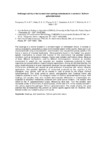Please use this identifier to cite or link to this item:
http://www.alice.cnptia.embrapa.br/alice/handle/doc/1037848| Title: | Antifungal activity of the isolated from caatinga actinobacteria in control of Pythium aphanidermatum. |
| Authors: | PAMPLONA, R. de C. de A.  VILELA, E. S. D.   PANSA, C. C.   CASTELIANI, A. G. B.   MOITINHO, M. A.   MELO, I. S. de   |
| Affiliation: | R. de C. de A. PAMPLONA, Hermínio Ometto University; E. S. D. VILELA, ESALQ/USP; C. C. PANSA, ESALQ/USP; A. G. B. CASTELIANI, ESALQ/USP; M. A. MOITINHO, ESALQ/USP. |
| Date Issued: | 2015 |
| Citation: | In: CONGRESSO BRASILEIRO DE MICROBIOLOGIA, 28., Florianópolis. Anais... Florianópolis: Sociedade Brasileira de Microbiologia, 2015. Ref. 0969-2. |
| Description: | The Caatinga is a biome located in a semiarid region of northeastern Brazil. It consists of various ecosystems, presented a unique environmental system of this country. Because it is an environment with unique characteristics, recent studies have revealed the private wealth of this biome in terms of microbial biodiversity. Microorganisms found in this habitat may present specific mechanisms to ensure their survival in this environment that provides extreme conditions, such as temperature changes, intense solar radiation and hydrous stress. Because of these different mechanisms used by different microorganisms, becomes an enabling environment to search for new enzymes and bioactive substances produced by these organisms can present different biotechnological applications. Among all microbial diversity, the group of actinobacteria is of great importance, because they are responsible for producing most of the known antibiotics and present as great producers of enzymes with various industrial applications. One possible application of compounds produced by this organism is the phytogenic fungi combat, such as rot caused in roots of plants by the fungus Pythium aphanidermatum. This study aimed to search actinobacteria from Caatinga biome with metabolic potential to work in the biological control of Pythium aphanidermatum fungus. With Caatinga soil samples, they were isolated actinomycetes differences in morphologies and subjected to extraction metabolites produced from solid culture medium. The extracts were tested on the P. aphanidermatum fungus diffused by drive test. From the isolation were recovered a total of 272 strains of actinomycetes, of this total 47% of the isolates showed in vitro activity against the pathogen Pythium aphanidermatum. The results showing the great potential that actinobacteria may present as control agents against root rot. However, more detailed studies are needed to prove such results. |
| Thesagro: | Caatinga Pythium Aphanidermatum |
| NAL Thesaurus: | Actinobacteria |
| Type of Material: | Resumo em anais e proceedings |
| Access: | openAccess |
| Appears in Collections: | Resumo em anais de congresso (CNPMA)  |
Files in This Item:
| File | Description | Size | Format | |
|---|---|---|---|---|
| 2015RA017.pdf | 71,79 kB | Adobe PDF |  View/Open |









